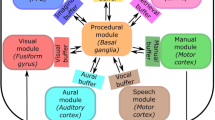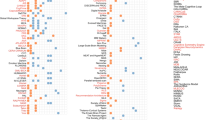Abstract
Cognitive models provide a principled alternative for hypothesis testing and measuring individual differences. However, many cognitive models are computationally intensive to simulate, making their use difficult. Using approximations can make the application of cognitive models more tractable. We compare the standard and hybrid approximations of the base-level activation equation for the ACT-R cognitive architecture with respect to four criteria: (1) preservation of core properties, (2) computational efficiency, (3) robustness to violations of assumptions, and (4) mathematical tractability. Contrary to a core property of the theory, activation for the standard approximation was non-monotonic with respect to the decay parameter, rendering it unidentifiable. Consequentially, the standard approximation is not valid for investigating individual differences in decay or experiments designed to manipulate decay. However, monotonicity is largely preserved with the hybrid approximation. Additionally, we show that both approximations are equally more computationally efficient than the exact equation. Furthermore, the hybrid approximation can achieve the same level of computational efficiency as the standard approximation while achieving greater accuracy. Our robustness analysis reveals that the hybrid approximation is more robust to violations of the assumption of equally spaced retrievals compared to the standard approximation. However, the hybrid approximation sacrifices some mathematical tractability in order to achieve improvements along the other criteria. Based on these findings, we encourage the use of the hybrid approximation for parameter estimation.




Similar content being viewed by others
Notes
We explicitly exclude the possibility that d = 1 because neither of the approximations discussed below are defined at that value.
This reflects a more fundamental issue with the formulation of base-level activation that we do not address here, as our focus is on comparing the approximations.
As mentioned by a reviewer, taking the log or non-integer power of a dimension, such as time, is problematic because the dimension will become scale dependent, causing the values of various parameters to change.
References
Anderson, J.R. (1982). Acquisition of cognitive skill. Psychological review, 89(4), 369.
Anderson, J.R. (2007). How can the human mind occur in the physical universe? Oxford: Oxford University Press.
Anderson, J.R., Bothell, D., Lebiere, C., Matessa, M. (1998). An integrated theory of list memory. Journal of Memory and Language, 38(4), 341–380.
Anderson, J.R., Bothell, D., Byrne, M.D., Douglass, S., Lebiere, C., Qin, Y. (2004). An integrated theory of the mind. Psychological Review, 111(4), 1036.
Brown, S., & Heathcote, A. (2003). Averaging learning curves across and within participants. Behavior Research Methods Instruments, & Computers, 35(1), 11–21.
Dancy, C.L., Ritter, F.E., Berry, K.A., Klein, L.C. (2015). Using a cognitive architecture with a physiological substrate to represent effects of a psychological stressor on cognition. Computational and Mathematical Organization Theory, 21(1), 90–114.
Estes, W.K. (1956). The problem of inference from curves based on group data. Psychological bulletin, 53(2), 134.
Fisher, C.R., Myers, C., Reem, H.M., Stevens, C., Hack J., Charles, G., Gunzelmann, G.G. (2017). A cognitive-pharmacokinetic computational model of the effect of toluene on performance. In Gunzelmann, GG, Howes, A, Tenbrink, T, Davelaar, E (Eds.) Proceedings of the 39th Annual Conference of the Cognitive Science Society. Austin: Cognitive Science Society.
Halverson, T., Gunzelmann, G., Moore Jr, L.R., Van Dongen, H.P. (2010). Modeling the effects of work shift on learning in a mental orientation and rotation task. In: Proceedings of the 10th international conference on cognitive modeling, pp 79–84.
Harris, J. (2008). Mindmodeling@ home: a large-scale computational cognitive modeling infrastructure. In: Proceedings of the 6th annual conference on systems engineering research.
Hintzman, D.L. (1984). Minerva 2: a simulation model of human memory. Behavior Research Methods, 16(2), 96–101.
McClelland, J.L. (2009). The place of modeling in cognitive science. Topics in Cognitive Science, 1(1), 11–38.
Newell, A. (1990). Unified theories of cognition. Cambridge: Harvard University Press.
Nosofsky, R.M. (1986). Attention, similarity, and the identification–categorization relationship. Journal of experimental psychology: General, 115(1), 39.
Petrov, A.A. (2006). Computationally efficient approximation of the base-level learning equation in ACT-R. In: Proceedings of the seventh international conference on cognitive modeling, pp 391–392.
Petrov, A.A, & Anderson, J.R. (2005). The dynamics of scaling: a memory-based anchor model of category rating and absolute identification. Psychological review, 112(2), 383.
Riefer, D.M., Knapp, B.R., Batchelder, W.H., Bamber, D., Manifold, V. (2002). Cognitive psychometrics: assessing storage and retrieval deficits in special populations with multinomial processing tree models. Psychological Assessment, 14(2), 184.
Shiffrin, R.M., & Steyvers, M. (1997). A model for recognition memory: REM—retrieving effectively from memory. Psychonomic bulletin & review, 4(2), 145–166.
Siegler, R.S. (1987). The perils of averaging data over strategies: an example from children’s addition. Journal of Experimental Psychology: General, 116(3), 250.
Stephens, R. (2013). Essential algorithms: a practical approach to computer algorithms. New York: Wiley.
Turner, B.M, Van Maanen, L., Forstmann, B.U. (2015). Informing cognitive abstractions through neuroimaging: the neural drift diffusion model. Psychological review, 122(2), 312.
Vandekerckhove, J. (2014). A cognitive latent variable model for the simultaneous analysis of behavioral and personality data. Journal of Mathematical Psychology, 60, 58–71.
Walsh, M.M., Gunzelmann, G., Van Dongen, H.P. (2017). Computational cognitive modeling of the temporal dynamics of fatigue from sleep loss. Psychonomic Bulletin & Review, 24(6), 1785–1807.
Yechiam, E., Busemeyer, J.R., Stout, J.C., Bechara, A. (2005). Using cognitive models to map relations between neuropsychological disorders and human decision-making deficits. Psychological Science, 16(12), 973–978.
Acknowledgements
The views expressed in this paper are those of the authors and do not reflect the official policy or position of the Department of Defense or the US Government. Approved for public release; distribution unlimited. Cleared 06/06/2018;88ABW-2018-3530. CF’s contributions to this work were supported by a postdoctoral research associateship, administered by the Oak Ridge Institute for Science and Education (ORISE).
Funding
This work was supported by the Air Force Research Laboratory’s Warfighter Readiness Research Division and the Air Force Office of Scientific Research (grant 18RHCOR068).
Author information
Authors and Affiliations
Corresponding author
Rights and permissions
About this article
Cite this article
Fisher, C.R., Houpt, J. & Gunzelmann, G. A Comparison of Approximations for Base-Level Activation in ACT-R. Comput Brain Behav 1, 228–236 (2018). https://doi.org/10.1007/s42113-018-0015-3
Published:
Issue Date:
DOI: https://doi.org/10.1007/s42113-018-0015-3




